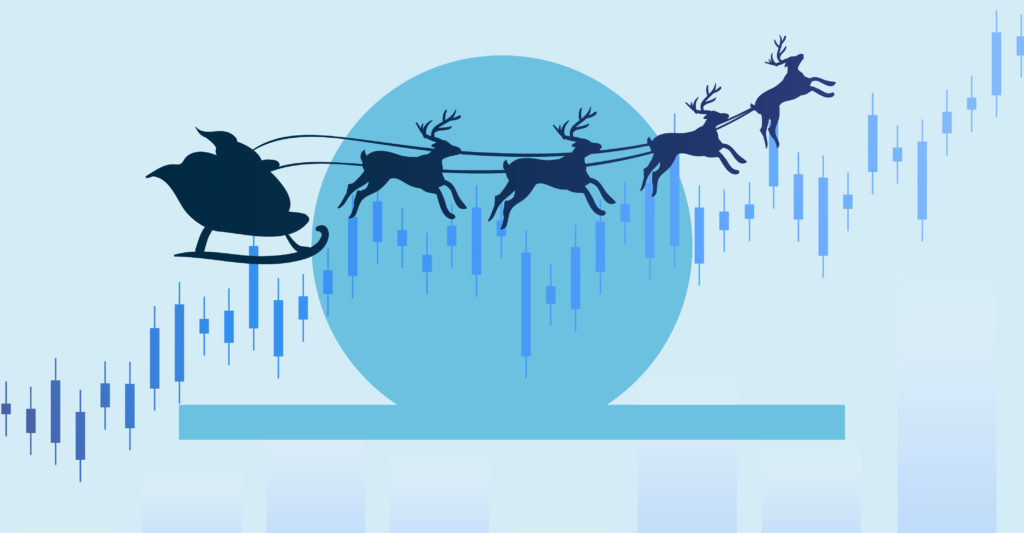Last Updated on Dec 23, 2022 by
A phenomenon when the stock market can see an upward trend in the last week of December is called the Santa Claus rally. But a stock market can rally at any time, which is unpredictable; what’s special about the Santa Claus rally? Let us find it out in this article, along with what’s special about the Santa Claus rally, what causes it, and expert views on the same
Table of Contents
Santa Claus rally meaning
As mentioned above, the Santa Claus rally refers to a situation where the market rallies towards the end of December. History says that the stock market delivers positive results during this phase.
It is to be noted the period for Santa Claus is still vague as a few say it occurs the week before Christmas, while a few say it starts in the week after Christmas. But in this article, we are considering the stats taken in the week after Christmas.
The first occurrence of the Santa Claus rally took place in 1972 when the market was abnormally high during Christmas until the initial few days of the New Year. The best example of this phenomenon is the one that occurred in December 2008, when the S&P 500 saw a gain of 7.36% from the 24th of the month to the 5th of January 2009.
Does the Santa Claus rally occur in the Indian markets?
Though the Santa Claus rally is not limited to any particular country, this is a lesser-known phenomenon in India. But for the last few years, the Indian stock market also started seeing a small upward trend in the last week of December. In the last 15 days of 2020, Nifty 50 gave a 2.2% return, delivering 1.7% in 2019, 0.5% in 2018, and 1.9% in 2017.
However, the rally is quite evident in the US stock market, and the phenomenon has also been observed in the Indian markets.
Here’s the data to give the numbers of the S&P 500 and Nifty markets in the last 15 days of December.
| Year | S&P 500 (%) | Nifty (%) |
| 2020 | 0.8 | 2.2 |
| 2019 | 0.9 | 1.7 |
| 2018 | -4.4 | 0.5 |
| 2017 | -0.1 | 1.9 |
| 2016 | -0.9 | 0.6 |
| 2015 | 0.1 | 0.4 |
| 2014 | -0.1 | 0.9 |
| 2013 | 0.4 | 0.4 |
| 2012 | -1.7 | 0.9 |
| 2011 | -0.6 | -1.9 |
“With the global markets being integrated to a large extent, the Santa Claus rally is not bound by any one market. Significant moves in the US market may impact Asian markets like India as the stock market in India and US exhibit moderate to high correlation. The FIIs and FPIs are also inactive during this time due to the holiday season. This results in low volume and active participation from retail investors who are generally bullish,” says Arvind Kothari of Niveshaay Investment Advisors.
What does the historical data show?
Arvind Kothari says, “According to research, this rally occurred 76% between 1950 to 2019, with the market rising on average of 1.3% each year in the US. Another news report claims that the Santa Claus rally was seen in 34 out of the last 45 yrs, with an average return of 1.4% in the US. The Indian market has also delivered positive returns in nine out of the past 10 calendar years in the last two weeks of December.”
Causes for a Santa Claus rally
There is no single theory that can explain the behaviour of the stock market at the end of the year. Some of the causes for the Santa Claus rally are:
- Being the holiday season, some institutional investors take leave, allowing retail investors to be bullish.
- Few investors tend to buy stocks ahead, anticipating a rally in January.
- A few investors are in Christmas and New Year’s cheer, hoping for optimistic growth.
- A few investors invest their new year or Christmas bonus in the stock market.
According to Alok Jain of Weekend Investing, “the phenomenon has more to do with fund flows than any fundamentals. It has been seen in the past several years that each year the markets make a bottom in the second or third week of December for a Santa/new years rally to last till the latter part of January or early February.”
| Date low | Nifty | Date high | Nifty | % Change |
| 26 December 2016 | 7,908 | 1 February 2017 | 8,716 | 10.2% |
| 18 December 2017 | 10,074 | 29 January 2018 | 11,171 | 10.8% |
| 26 December 2018 | 10,004 | 21 January 2019 | 10,987 | 9..82% |
| 11 December 2019 | 11,832 | 20 January 2020 | 12,430 | 5.05% |
| 21 December 2020 | 13,777 | 21 January 2021 | 14,753 | 7.08% |
| 20 December 2021 | 16,410 | 18 January 2022 | 18,351 | 11.82% |
Can we expect a Santa Claus rally in 2022?
Alok says, “the evidence is there to see, yet there cannot be any certainty of this outcome. In my opinion (no relevance to Weekend Investing smallcase) is that we will see a good run in the 25 December – January end period on expectations of a growth budget and increased allocation to India by global funds. However, the best way to navigate the markets remains to stay invested longer using a self-correcting strategy like Momentum Investing that can relieve you from the vagaries of trying to guess the timing or selection of stocks or sectors in the markets.”
And as for Arvind Kothari, “Even though the past probabilities are good, investors should exercise caution as such a phenomenon is not guaranteed but only an anomaly. Many external factors like rising COVID cases, Fed’s stance for interest rate, China +1 strategy, etc., would impact the market going forward.”
Talking about the Santa Claus rally in India in 2022, Sonam Srivastava of Wright Research says, “This year we do not see the Santa Claus rally driving momentum in the India market as the domestic sentiment has been quite negative and the last few months buying has mostly come from FIIs. Without FIIs in December, we can expect selling pressure from domestic investors. We do expect the prices to restabilise in January, though.”
Divam Sharma of Green Portfolio says, “Santa has come in early, giving us a tremendous opportunity to invest at highly discounted valuations. Notably, the broader markets are offering some real value investment opportunities. Lower the price, lower the risk. We are seeing many of our small and midcap companies coming to dream valuations where we can benefit from a tremendous upside from hereon.”
“The markets are selling on the Covid rumours and will see buying on confirmations around expectations. The smart money, the FIIs and DIIs are buying these corrections, which reflects another level of confidence in the Indian story. We are also looking forward to a growth budget, which the Government has indicated will fuel the long-term growth of India. This year, we are expecting a post-Christmas and New Year rally,” Divam adds.
How to take part in the Santa Claus rally?
There is no separate procedure to invest in the stock market during the Santa Claus rally period. Log in to Tickertape and Watchlist your preferred stocks in advance. Monitor their performance. You can buy/sell them at an appropriate time according to your investment goal. However, it is important to check with your investment advisor before investing.
Conclusion
The Santa Claus rally is a movement caused during a particular market period. Though history shows that stock prices rally during this period, investors should be aware that buying or selling during that period doesn’t guarantee returns. Also, stock prices may fall during this period. Hence you need to assess your risk appetite and make a wise investment decision.
FAQs
When does the Santa Claus rally begin?
There is no particular date for the Santa Claus rally to begin. But usually, it begins in the last week (trading days) of December.
What is the Santa Claus rally period?
The phenomenon usually begins in the last week (trading days) of December and lasts till the first two days of January.
Is the Santa Claus Rally real?
While looking at the stock market’s history since 1972, the market outperformed in the last week (trading days) of December and lasted till the first two days of January. Observing the upward trend during this phase, the Santa Claus rally looks real. However, the causes behind the rally are not proven, so this could be a mere possibility rather than a definite occurrence.
- Best Performing Small-Cap Mutual Funds in India (2025) - Apr 15, 2025
- Best Equity Mutual Funds in India: Compare Top SIP Options - Apr 15, 2025
- Top SIP Mutual Funds in India (2025) - Apr 15, 2025




